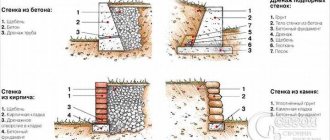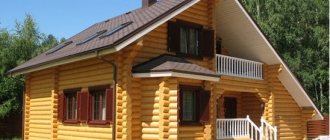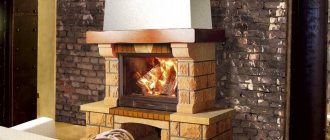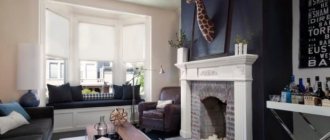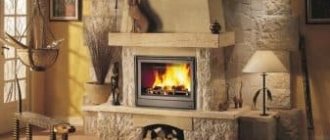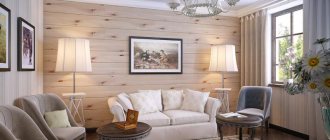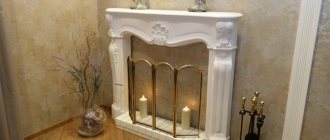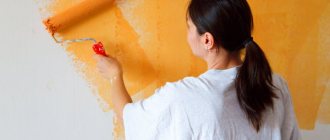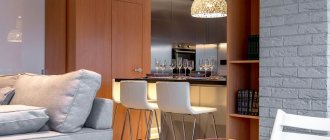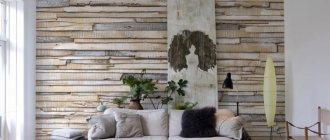Stylistic design of fireplaces
Today, fireplace designs differ in material and heating method:
- they can be large, like ancient buildings,
- or not large and compact, which will fit into a medium-sized city apartment.
A wide selection of decorative fireplaces allows the home owner to choose the right model for an interior decorated in a certain style. Different designs of fireplaces will complement your home with warmth and comfort and emphasize the stylistic character of the room. For lovers of antiquity, the following types of fireplaces are offered.
Selecting materials for cladding a stove or fireplace
There is no fundamental difference in the finishing of these heating structures. Everything used to line a stove is suitable for a fireplace. But the requirements for finishing materials in both cases are quite specific:
- High thermal resistance;
- Good thermal conductivity (thermal output);
- Mechanical strength;
- Strong adhesion to the solution;
- Aesthetic appearance.
You don't have to invent a new type of cladding. The practice of stove making offers many options for performing this work and materials for its implementation.
Professional craftsmen use the following materials for finishing stoves and fireplaces:
- Brick;
- Ceramic tiles (terracotta or majolica);
- Tiles;
- Natural stone (marble, basalt, sandstone, slate, granite).
In recent years, they have been joined by artificial stone and soapstone.
Classical
The classic design option for a fireplace in the interior is a structure with a U-shaped portal with an open firebox. The main materials for manufacturing are:
- marble,
- granite,
- semi-precious natural stone,
- cast iron,
- tree.
You can use tiles to decorate the fireplace with your own hands. Engraving and carving highlight the elegance of the classics.
Classic designs are made wall-mounted or built into the wall. The chimney of a wall-mounted fireplace is hidden with a plasterboard casing.
Since this type is powerful, it is installed in large rooms. For safety reasons, fireplaces began to be supplemented with doors: the closed type avoids the risk of fire.
How to veneer a fireplace with stone
Finishing a fireplace with stone is technologically not much different from laying tiles. The difference is in working with the material itself, but there are almost no technical features. The only thing is that when using natural flagstone, be sure to cover the fireplace with mesh. Without it it will fall off.
Finishing the fireplace with stone is one of the options
Features of working with artificial gypsum stone
This type of decorative stone is inexpensive and lightweight; it can be used to decorate fireplaces, especially without overloading the ceilings. There are only some nuances, without which you will not achieve a good result.
The technology for producing gypsum stone is such that each element has some irregularities, sagging, and protrusions. We grind them off with a knife, fortunately the plaster is cut without problems. We grind each cladding element so that at the back, around the perimeter, a frame is formed with an angle of 45° (or so).
Moreover, often the corner elements of the gypsum decorative stone are several millimeters higher than the ordinary ones from the same collection. In order for the cladding to look monolithic, this difference also has to be removed - grinded down. When all the cladding elements are adjusted, they can be glued into place. Heat-resistant glue is used for cladding fireplaces, although with the correct design it almost does not heat up.
Working with natural stone
Most often, fireplaces are faced with natural stone, sawn into plates. It is also called flagstone or stone tiles. The shape of all the fragments is different, you have to adjust it to make everything look beautiful. In this case, it is definitely better to first lay out the entire picture on some plane, select and process the elements. Only after the mosaic is complete can it be glued. The entire technology for installing a fireplace on the walls is described above and is practically no different. The whole process can be seen in the video.
Rustic or country styles
For interiors of these two styles, fireplaces are designed in the same design. Massive structures are made from wild stone or wood in a rough design.
The D-shape of rustic fireplaces includes a niche with wood under the firebox. A wooden beam is placed above it, and then there is a casing with a chimney.
The decorative finishing of the fireplace is made of brick or sandstone, which is artificially aged. Sometimes its appearance resembles a stove.
Such models are typical for country or country-type houses with a large area and high ceilings. Only experienced craftsmen can build them.
Decorating a fireplace with natural brick is beautiful
If your fireplace was built by a professional stove maker and has no distortions, blemishes, chips or cracks, you don’t have to resort to expensive finishing, but simply coat the brick with heat-resistant stone varnish. The varnished surface perfectly repels dirt and soot, water and dust, as a result you will get a beautiful fireplace in the Old English style without extra costs.
Fireplace decoration with natural brick
Is it possible to make something beautiful out of simple plaster?
If the masonry is not even enough, or you don’t like the look of natural brick, you can resort to an inexpensive finishing method that was very popular in the old days - plaster the fireplace and cover it with a layer of heat-resistant paint. Advantages of this method:
- Low price of materials;
- The method is easy to perform and does not require special skills or the use of tools;
- It's easy to refresh or repaint your fireplace, giving it a new look;
- The cladding does not weigh down the fireplace, and there is no need to strengthen the foundation.
Plastered fireplace
Finishing a fireplace using plastering and painting includes several stages:
- Prepare the surfaces of the fireplace - remove dirt, dust, and old plaster, if any, from the surface. This is done using a spatula or sander. After cleaning, the surface is treated with a primer.
- After cleaning, the surface of the fireplace is moistened to reduce dust and the masonry seams are opened by 0.5-1 cm - this is necessary for better adhesion of the plaster mortar to the brick.
- The fireplace is pre-heated and dried. When plastering, its surface must be warm, otherwise cracks will appear on the plaster at the first heating.
- The reinforcing mesh is secured to the surface of the masonry using small nails. It will serve to strengthen the plaster layer.
- For plastering and finishing, special heat-resistant mixtures are used - you can buy them in construction stores. The mixture is poured into water in the recommended proportion and thoroughly mixed with a construction mixer until smooth.
Heat-resistant mixtures for plastering fireplaces
- The plaster is applied using two spatulas: narrow and wide.
Using a narrow spatula, scoop up the solution and distribute it evenly across the width of the large spatula, and then apply the distributed mixture to the surface of the fireplace. Use a narrow spatula to trim internal corners and raised protrusions. Applying plaster to the mesh - You can also use the old-fashioned method as a solution - a mixture of clay and sand. Fatty clay is mixed with sand in approximately a 1:1 ratio, diluted with water so that the mixture does not spread, but also does not form cracks when leveling it with a spatula. Apply the solution in the same way, rubbing it with a wooden float and finally leveling it with a piece of burlap or other coarsely woven fabric.
- The solution is dried for several days. For clay plaster, it is quite possible that it will take about a week, during which the fireplace needs to be slightly heated, especially in the cold season.
Drying a plastered fireplace
- A layer of paint or special decorative putty for stoves is applied on top of the plaster. Fireplaces require heat-resistant silicone paint, and you can give it the desired shade using a water-soluble color.
- Painting a fireplace can be done without plaster, directly on the brick - in some cases, such fireplaces fit perfectly into the design of the house.
Painting the fireplace with heat-resistant paint
This method has a drawback - the finish is not durable, and with accidental impacts it is prone to crumbling, especially at corners. This defect can be corrected by lining the corners with stone or tiles, and how to do this - read below.
Video - finishing a fireplace with decorative plaster
Fireplace in Provence style
“French country” differs from rough rustic in its lighter and simpler design, but also with natural motifs.
A fireplace made of natural stone is decorated with tiles or wood, often painted in light shades and having a shabby and worn effect.
Forged doors and other elements are painted white or aged with a patina. All this emphasizes the vintage touch in the interior design.
How to build a snow igloo with your own handsWhat work needs to be done in the fall to prepare fruit trees for winter
Propagation of black currants by cuttings in autumn: instructions and useful tips
A Provence style fireplace gives a cozy atmosphere and a feeling of comfort. It can be installed even in a spacious bedroom, where warmth and comfort are valued. Decorating fireplaces - photo ideas in our selection:
Installation of a false fireplace
A fireplace, the portal of which will be equally suitable for both a home and an apartment, is a decorative design. A false fireplace is safe to use because there is no real fire burning in its firebox. The fireplace, a photo of which you can find in this article, is a high-quality imitation!
A room in which the fireplace is a false structure allows you not only to decorate the room stylishly, but also to hide various flaws, such as radiators, corners, and to compensate for interior deficiencies.
The fireplace lining can be made of various materials, such as porcelain stoneware, stone, plaster, tiles. The hearth can be decorated with candles, books, figurines, photo frames and other decor.
Another suitable option for an apartment is an artificial fireplace. It allows you to get a better imitation of fire than a false fireplace. The portal is assembled from plasterboard and metal profiles. Natural and artificial stone, tiles, decorative plaster, and mosaics are also used for cladding.
Modern style
Ready-made models can be selected in any shape and size. Do-it-yourself fireplaces in the Art Nouveau style are distinguished by simple geometric shapes; most often they choose a square or round design, as well as an elongated model that takes up little space.
Samples of the modern movement are universal; it is impossible to make a mistake in their choice.
Brand and production technology of material
Most construction and finishing materials have characteristic markings. Brick for fireplaces and stoves is no exception, and thanks to letters and numbers you can accurately determine how strong and resistant the material is to compression. Accordingly, the higher these indicators, the better quality the brick is offered, and in the end the product will have a good appearance.
For those who have not previously encountered the marking and do not understand what it means, experts decipher the question quite simply: depending on the density of the brick, the fireplace will heat up faster or slower, and retain heat longer or less. Accordingly, the denser the material, the longer it takes to heat up, but at the same time it retains heat for a longer time without the need to fire the stove again.
Standard sizes of different types of bricks
Experts draw the attention of novice craftsmen to the fact that the cladding method, as well as the material used, directly depends on how the structure will be used in the future. In situations where the stove structure will play the role of the main heating element of the entire house or room, it is necessary to purchase material with a marking of at least M250, and preferably higher.
Good to know: How to make a fireplace in a gazebo, practice of building a gazebo and fireplace
The main attention here will be paid not so much to the rate of heating, but to the duration of subsequent heat retention. If the brand of brick is smaller, then the time to maintain sufficient temperature in the room will be unsatisfactory, and the fireplace will have to be constantly heated, which will lead to excessive fuel consumption.
When a fireplace is built as an additional source of heat or an interior element, it is assumed that the structure will be used only from time to time. In this situation, a material with a lower density can be used.
In addition to the ability to retain heat, highly labeled finishing materials are characterized by attractive decorative qualities. There are always no abrasions or roughness on the front surface, it is smooth, without depressions or flaws, there are also no cracks or chips. At the same time, the back side, on the contrary, is rough, which provides better adhesion to the main surface of the fireplace.
High tech
Hi-tech style fireplace stoves 2021 amaze with their diverse design. Straight lines can be combined with smooth and curved ones, creating an unusual design of eye-catching geometry.
Abstract forms will add originality to the style, because in a high-tech interior you can often see things that are strange at first glance, which then seem to be an integral part of the room.
One of the popular types of fireplaces is a firebox built into a table with your own hands. Thus, a multifunctional design is obtained.
Modern technologies make it possible to produce samples with a rotating mechanism and additional decorations.
Construction materials
Before organizing work, it is necessary to draw up a special project that meets all fire safety requirements and will become a key element of the room’s interior. After this, the materials necessary for the lining are purchased. The list includes:
- bricks (stone);
- sand;
- cement;
- reinforcing mesh;
- shovel;
- Master OK;
- Bulgarian;
- dishes for mixing the solution.
It is not recommended to use sand-lime bricks for finishing fireplaces. This type of material is not intended for use at high temperatures. The best solution to the problem would be a cast-iron stove made of fireclay bricks, which are not only immune to destruction due to heat, but are also capable of maximizing the accumulation and release of heat. The solution for work is prepared with your own hands; for this, sand, clay and cement are mixed in the required proportions. As for the clay material, it should first be soaked in water and then added to the main mixture.
It is important to think through the design of the inserts in advance, since during the work there will not be time for this.
Marking
The facing brick is marked, for example: DIN 105 – VHLz B 28 – 2.0 – 2 DF. What does it mean: multi-hollow with class B hollowness, with density class 2, compressive strength class 28, in format 2 DF, which means size 240*113*14mm.
But only foreign-made bricks are marked this way. Domestic is marked as follows. Marking of facing bricks 1–NF F50 M25. Where 1- NF means size F50 means frost resistance on a scale from 35 to 100. M25- means mechanical strength. The higher the number, the stronger the brick.
Related article: Interior doors with photo printing in the interior
Surface preparation
Before proceeding with the coating itself, it is necessary to properly process the plane. You can install it almost anywhere.
To ensure a high-quality implementation of the introductory stage, the masters take into account the following important points:
- When cladding with wood, you need to remember how strongly it absorbs moisture. To minimize exposure before finishing work, it is necessary to apply a reliable waterproofing compound to the wood. If a specialist works with concrete or metal, you can refuse the waterproofing layer.
- The second stage is the installation of a special mounting grid, which is fixed with self-tapping screws. It is recommended to close their caps with washers for maximum reliability. There should be a distance of 5 cm horizontally and 15 cm vertically between fasteners. Installing the mesh allows you to achieve even masonry.
- Next, the plaster is applied by a professional. The thinnest layer is 1 cm, but ideally the layer is created thicker.
- When the master works with a fireplace portal made of concrete or brick, space is allocated for laying artificial stone to eliminate possible errors.
- When placing shaped elements, a special solution is used that is resistant to high temperatures. It can be a mixture of fireclay and cement or clay.
